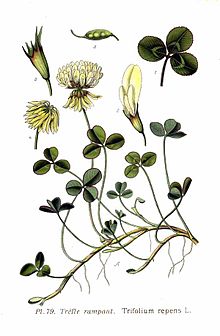| Clover | |
|---|---|

| |
| Trifolium repens (white clover) | |
| Scientific classification | |
| Kingdom: | Plantae |
| Clade: | Tracheophytes |
| Clade: | Angiosperms |
| Clade: | Eudicots |
| Clade: | Rosids |
| Order: | Fabales |
| Family: | Fabaceae |
| Subfamily: | Faboideae |
| Clade: | Inverted repeat-lacking clade |
| Tribe: | Trifolieae |
| Genus: | Trifolium L. |
| Subgenera and sections[1] | |
|
subg. Chronosemium
| |
| Synonyms[2] | |
| |
Clovers, also called trefoils, are plants of the genus Trifolium (from Latin tres 'three' and folium 'leaf'), consisting of about 300 species of flowering plants in the legume family Fabaceae originating in Europe. The genus has a cosmopolitan distribution with the highest diversity in the temperate Northern Hemisphere, but many species also occur in South America and Africa, including at high altitudes on mountains in the tropics.
They are small annual, biennial, or short-lived perennial herbaceous plants, typically growing up to 30 cm (12 in) tall. The leaves are trifoliate (rarely, they have four or more leaflets; the more leaflets the leaf has, the rarer it is; see four-leaf clover), with stipules adnate to the leaf-stalk, and heads or dense spikes of small red, purple, white, or yellow flowers; the small, few-seeded pods are enclosed in the calyx.[3] Other closely related genera often called clovers include Melilotus (sweet clover) and Medicago (alfalfa or Calvary clover).
As legumes, clovers fix nitrogen using symbiotic bacteria in their root nodules, and are used as an alternative or supplement to synthetic nitrogen fertilizers. They are also valuable food source for grazing livestock and bees. The domestication of clover caused substantial increases in agricultural productivity.
- ^ "Species Nomenclature in GRIN". Archived from the original on 2008-10-14. Retrieved 2010-08-04.
- ^ Trifolium Tourn. ex L. Plants of the World Online. Retrieved 22 September 2023.
- ^ Cite error: The named reference
EB1911was invoked but never defined (see the help page).